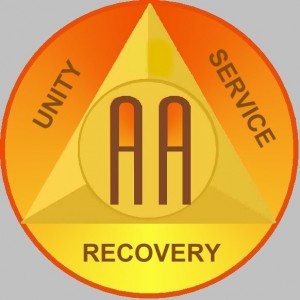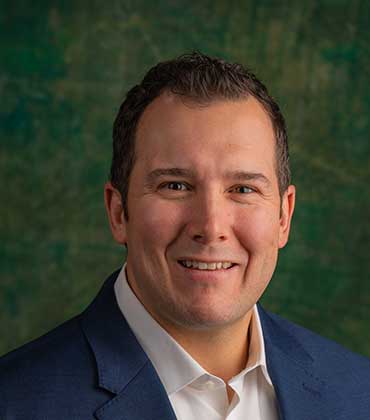“The circle stands for the whole world of AA, and the triangle stands for AA’s Three Legacies of Recovery, Unity, and Service. Within our wonderful new world, we have found freedom from our fatal obsession. That we have chosen this particular symbol is perhaps no accident. The priests and seers of antiquity regarded the circle enclosing the triangle as a means of warding off the spirits of evil, and AA’s circle and triangle of Recovery, Unity, and Service has certainly meant all of that to us and much more.” -Bill W., Alcoholics Anonymous Comes of Age, 1955 speech) (p. 139)

What is the Circle and Triangle Symbol?
The remedy to addiction and alcoholism is represented by the circle and triangle. This is an old spiritual symbol that represents the mind, body, and spirit as one.
The triangle symbol in AA reflects the three principles or legacies of our program (recovery, unity, and service) that are the remedies to the three-part disease of alcoholism (physical, mental, and spiritual). The use of the circle that surrounds the triangle depicts Alcoholics Anonymous in its entirety.
The equilateral triangle is the strongest structure known to us. Since all three sides are equal, the triangle represents the balance required between all 36 guiding spiritual principles someone needs to maintain sobriety. A sobriety circle if you will.
First, we base our solution on the triangle, which represents our work with the steps to recovery. Our minds change, our words change, our actions change, and our personalities change, resulting in our lives changing for the better. The disease of addiction is cyclical until steps to break it are made.
At Jaywalker in Carbondale, Colorado, we understand the value of the alcoholics anonymous symbol. This trademark has ancient spiritual roots and depicts the unity of mind, body, and spirit. We were not only emotionally and physically ill; we were also spiritually ill. The idea is that someone will recover and achieve mental, physical, and spiritual wholeness if they take action in all three areas.
Comparing the AA Symbol to Other Recovery Icons
The circle and triangle are not the only symbols used in addiction recovery. Several others also represent recovery, transformation, and sobriety:
- The Serenity Prayer Symbol – Found on recovery medallions and literature, this represents surrender, acceptance and faith—key to AA’s program.
- The Phoenix – Some recovery communities use the phoenix to represent rebirth, rising from the ashes of addiction into a new life of sobriety.
- Butterfly Imagery – Many in recovery resonate with the butterfly as a symbol of transformation, representing the personal growth that happens through the 12-step process.
- The Recovery Triangle (Different from AA’s Symbol) – Some use a different triangle to represent the three parts of healing: mind, body and spirit, without the circle.
While these symbols are meaningful, AA’s circle and triangle are unique because of their direct connection to the Three Legacies: Recovery, Unity and Service. Unlike general symbols of transformation, this emblem ties to AA’s program structure.

History of the Alcoholics Anonymous Ancient Symbol and The Three Legacies
The Three Legacies (Recovery, Unity, and Service) were passed down to us by our co-founders, Dr. Bob, Bill W., and the early AA pioneers. Each legacy contains twelve guiding spiritual principles. There are a total of 36 guiding principles contained in The Big Book of Alcoholics Anonymous (Recovery, Unity, Service), the Twelve Steps and Twelve Traditions (Recovery and Unity), and the General Service Manual (Service) all incorporate a holistic theme.
What do the alcoholics anonymous triangle and use of the circle come from or represent? This is a common query among newcomers at AA meetings. Since it was registered in 1955, it has become a prominent emblem for members of Alcoholics Anonymous.
The triangle represents the three key answers to the three-part disease of alcoholism for individuals in recovery meetings. The circle surrounding the triangle depicts recovery or AA itself in its entirety.
In the early 1990s, however, A.A.W.S. decided to discontinue the use of the circle and triangle symbols in its literature, stationery, and other materials. It had become too expensive and contentious for AA to continue defending its rights to this sign.
After the 1994 General Service Conference determined that the logo be withdrawn from all Conference-approved literature, it was “officially” and “legally” taken out. However, the emblem is still connected with Alcoholics Anonymous (and other types of 12-Step recovery groups) and holds unique value for AA members worldwide.
The Three Legacies

The triangle symbol represents the three AA legacies: recovery, service, and unity. The Alcoholics Anonymous program seeks to achieve balance in these three areas to assist alcoholics in remaining sober. Recovery, service, and togetherness are the keys to overcoming the disease’s three components: physical, mental, and spiritual.
Triangle Symbol Side 1: Recovery (Mind)
The set of 12 spiritual principles people follow to recover from alcoholism and addiction is known as recovery. This is the basis of AA alcoholics anonymous, and it is for this reason that the word “Recovery” appears at the bottom of the triangle on Alcoholics Anonymous coins. People claim that completing these 12 steps will eradicate bodily compulsion and mental preoccupation.
The 12 steps are referred to as “recovery”, and they serve as the core of our program. As a result, it is the bottom of the triangle, supporting Unity and Service. When we complete the 12 Steps, the bodily compulsion, and mental preoccupation are gone. The promise follows that we have healed from a “seemingly hopeless state of mind and body.” Unity and service cannot be a part of our lives until we apply these concepts in all aspects of our life.
Triangle Symbol Side 2: Unity (Body)
The second legacy is one of unity. This entails alcoholics anonymous members joining a group and attending meetings. This is especially vital in early sobriety so newcomers can find support and advice from individuals who have gone through recovery and the 12 steps.
After completing the 12 steps, people can help to support newcomers and act as sponsors. Long-term sobriety requires support groups, and this unity should extend beyond AA. Alcoholics Anonymous is a great place for people to meet and build lifetime friendships.
The second Legacy, “unity” proposes that we join a home group and attend meetings. Meetings and fellowship with recovered alcoholics might help a newbie stay sober until they finish their steps and find a higher power. The group members form the AA fellowship, which is affectionately referred to as “the meeting before the meeting, the AA meeting, and the meeting after the meeting.” More importantly, the group and its members are accountable for ensuring that the door to the meeting is open and available for the attendees.
Circle and Triangle Symbol Side 3: Service (Sprit)
The final legacy is service. This results from the spiritual awakening that occurs after completing the twelve steps. Service, therefore, entails spreading this message to other alcoholics and putting these ideas into practice in daily life.
Those in AA can start serving right immediately by putting up chairs, pouring coffee, and assisting to clean up after meetings. Once the 12 steps have been completed, service can include sponsoring and guiding newcomers through the steps. There are numerous more methods for AA members to volunteer. This can include things like chairing meetings or being involved in the larger community.
The 12 Concepts, which are included in the General Service Manual and the Appendix to the Big Book (Fourth Edition), form the foundation of AA service. The current service system established by Bill W. and Dr. Bob allows recovered alcoholics to have resources available to them to assist another alcoholic in achieving sobriety.
At Jaywalker in Carbondale, CO, we think that the most important component of service is hard labor or helping others. For example, a milestone in recovery is achieved when a person struggling helps another person who is also struggling.
Finding a Happy Medium
For those in Alcoholics Anonymous, the three legacies establish balance, and the equilateral triangle is the strongest shape. This triangle can be found on Alcoholics Anonymous coins that represent crucial milestones, and it can assist those in recovery to stay strong, focused, and driven. We recover and are given the ability to help others, which is critical for long-term recovery.
Learn More About the Significance of the AA Symbol
The circle and triangle symbol has helped people learn how to maintain long-term sobriety. Understanding the three legacies is critical for everyone involved in AA, and this piece should teach you the fundamentals.
Using the Triangle and Circle as a Guide in Daily Life
Many in AA use the circle and triangle as more than just a symbol—it becomes a daily guide for living sober. Here’s how:
- Decision-Making – When faced with challenges members can ask themselves: “Am I in balance between recovery, unity and service?” If one is neglected it can weaken the whole.
- Daily Reflection – Some use the symbol as a mindfulness tool, to check in with their recovery (mind), their community (body) and their willingness to help others (spirit).
- Sobriety Milestones – Coins with the symbol are physical reminders of progress. Each milestone chip reinforces the journey and the principles that make lasting sobriety possible.
- Personal Growth – Even outside of AA the circle and triangle applies to life in general. Balance in mind, body and spirit is important for anyone seeking fulfillment not just those in recovery.
By living by these principles AA members stay sober and build lives of purpose, connection and meaning.
A Note from Mark Kloster On the AA Symbol
The Circle and Triangle symbol has long been connected with the AA Fellowship. It was adopted as an official symbol at the International Convention in St. Louis in 1955, and from that point on was widely used in the Fellowship.
In AA, the equilateral triangle represents the three-part answer (Unity, Recovery, and Service) to a three-part disease (Physical, Mental, and Spiritual) while the circle represents AA as a whole. The body should be triangular, stable, and the mind circular and open. The circle symbolizes serenity and perfection, and the source of unlimited potential. Together they represent the perfect union of mind and body.
Although in the early 1990s AA began to phase out the use of the circle and triangle on all conference-approved literature it is still widely regarded as the “unofficial” logo of the fellowship. It is used to identify AA meeting places and on AA coins to recognize sobriety time.
With Gratitude,
Mark Kloster
Alumni Coordinator






